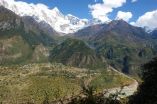INFORMATION:
A photo of the Yarlung Zangbo river is available here:
https://media.gfz-potsdam.de/gfz/wv/05_Medien_Kommunikation/Bildarchiv/_Einzelbilder_PM/GFZ-YarlungZangbo_MKabanGFZ.png
P. Wang, D. Scherler et al.: „Tectonic Control of Yarlung Tsangpo Gorge Revealed by a Buried Canyon in Southern Tibet", Science Nr. 6212, Vol. 346, pp. 978-980, 21.11.2014, DOI: 10.1126/science.1259041
Himalaya tectonic dam with a discharge
2014-11-20
(Press-News.org) The Himalaya features some of the most impressive gorges on Earth that have been formed by rivers. The geologic history of the famous Tsangpo Gorge, in the eastern Himalaya, now needs to be rewritten.
A team of German, Chinese, and American geoscientists have namely discovered a canyon, filled with more than 500 m of sediments beneath the bed of the present-day Yarlung Tsangpo River upstream from the gorge. Using drill cores, the scientists were able to reconstruct the former valley floor of this river, which allowed them to reconstruct the geological history of the Tsangpo Gorge (Science, 21.11.2014). They discovered that the gorge obtained its steep form in response to rapid tectonic uplift in the Himalaya, two to three million years ago. "Because of its high gradient, the river incises its bed very rapidly", explains Dirk Scherler from the GFZ German Research Centre for Geosciences. "The rocks here are eroded at annual rates of up to one centimeter per year which is matched by tectonic uplift of the same rate." The collision of India with the Eurasian continent has created a tectonic dam here.
This barrier caused a lower flow velocity of the Yarlung Tsangpoupstream. Previously, the river had deeply incised into the Tibetan Plateau. Due to the reduced flow rate the sediments which the Yarlung Tsangpo River and its tributaries eroded from the highlands were deposited in the river bed along hundreds of kilometers.
The scientists estimated that these deposits are up to 1000 m thick. "Five drillings have been conducted over a distance of 300 km upstream of the gorge", says Dirk Scherler. "One of the drillings encountered bedrock after 540 meters of sediments. From the drill cores, we were able to infer the reduction in stream flow velocity and date the initiation of sedimentation using cosmogenic nuclides. These are rare isotopes that are produced by cosmic rays near the Earth's surface. Three Million years ago, the river was still incising into Himalayan bedrock." But today the once huge canyon is buried by sediments.
The Yarlung Tsangpo is the largest high mountain river on Earth. It flows along a distance of 1700 km across the Tibetan Plateau, at an elevation of around 4000 meters and follows the boundary between India and Eurasia. In the eastern Himalaya, the river leaves the high plateau and breaks through the world famous, horseshoe-shaped Tsangpo Gorge for the plains of India.
The new findings show that rapid incision of the Yarlung Tsangpo and the development of the Tsangpo Gorge occurred in response to tectonic uplift, and not, as previously thought, the other way round. In addition, these observations refute existing hypotheses that relate the origin of the Tsangpo Gorge to river capture of the Yarlung Tsangpo by the Brahmaputra River.
ELSE PRESS RELEASES FROM THIS DATE:
New study reveals why some people may be immune to HIV-1
2014-11-20
Doctors have long been mystified as to why HIV-1 rapidly sickens some individuals, while in others the virus has difficulties gaining a foothold. Now, a study of genetic variation in HIV-1 and in the cells it infects reported by University of Minnesota researchers in this week's issue of PLOS Genetics has uncovered a chink in HIV-1's armor that may, at least in part, explain the puzzling difference -- and potentially open the door to new treatments.
HIV-1 harms people by invading immune system cells known as T lymphocytes, hijacking their molecular machinery to make more ...
Caltech geologists discover ancient buried canyon in South Tibet
2014-11-20
A team of researchers from Caltech and the China Earthquake Administration has discovered an ancient, deep canyon buried along the Yarlung Tsangpo River in south Tibet, north of the eastern end of the Himalayas. The geologists say that the ancient canyon--thousands of feet deep in places--effectively rules out a popular model used to explain how the massive and picturesque gorges of the Himalayas became so steep, so fast.
"I was extremely surprised when my colleagues, Jing Liu-Zeng and Dirk Scherler, showed me the evidence for this canyon in southern Tibet," says Jean-Philippe ...
Tropical rickettsial illnesses associated with adverse pregnancy outcomes
2014-11-20
Bangkok (Thailand)- A recent study from the Thai-Myanmar border highlights the severe and previously under-reported adverse impact of readily treatable tropical rickettsial illnesses, notably scrub typhus and murine typhus, on pregnancy outcomes, finding that more than one third of affected pregnancies resulted either in stillbirth or premature and/or low birth weight babies.
Conducted by Prof Rose McGready and Assoc. Prof Daniel Henry Paris from the Shoklo Malaria Research Unit (SMRU) in Mae Sot, Thailand, and the Mahidol Oxford Research Unit (MORU) in Bangkok, affiliated ...
University of Kentucky reports HIV/AIDS drugs could be repurposed to treat AMD
2014-11-20
LEXINGTON, Ky. (Nov. 20, 2014) - A landmark study published today in the journal Science by an international group of scientists, led by the laboratory of Dr. Jayakrishna Ambati, professor & vice chair of the Department of Ophthalmology & Visual Sciences at the University of Kentucky, reports that HIV/AIDS drugs that have been used for the last 30 years could be repurposed to treat age-related macular degeneration (AMD), as well as other inflammatory disorders, because of a previously undiscovered intrinsic and inflammatory activity those drugs possess.
AMD is a progressive ...
How to estimate the magnetic field of an exoplanet?
2014-11-20
Scientists developed a new method which allows to estimate the magnetic field of a distant exoplanet, i.e., a planet, which is located outside the Solar system and orbits a different star. Moreover, they managed to estimate the value of the magnetic moment of the planet HD 209458b.The group of scientists including one of the researchers of the Lomonosov Moscow State University (Russia) published their article in the Science magazine.
In the two decades which passed since the discovery of the first planet outside the Solar system, astronomers have made a great progress ...
Imagination, reality flow in opposite directions in the brain
2014-11-20
MADISON, Wis. -- As real as that daydream may seem, its path through your brain runs opposite reality.
Aiming to discern discrete neural circuits, researchers at the University of Wisconsin-Madison have tracked electrical activity in the brains of people who alternately imagined scenes or watched videos.
"A really important problem in brain research is understanding how different parts of the brain are functionally connected. What areas are interacting? What is the direction of communication?" says Barry Van Veen, a UW-Madison professor of electrical and computer engineering. ...
Halting the hijacker: Cellular targets to thwart influenza virus infection
2014-11-20
MADISON, Wis. - The influenza virus, like all viruses, is a hijacker. It quietly slips its way inside cells, steals the machinery inside to make more copies of itself, and then -- having multiplied -- bursts out of the cell to find others to infect.
Most drugs currently used to treat influenza are designed to attack the virus, to render it incapacitated. But influenza viruses are sneaky, capable of mutating to avoid destruction by the drug.
In a comprehensive new study published today in the journal Cell Host and Microbe, the University of Wisconsin-Madison's Yoshihiro ...
UO-industry collaboration points to improved nanomaterials
2014-11-20
EUGENE, Ore. -- Nov. 20, 2014 -- A potential path to identify imperfections and improve the quality of nanomaterials for use in next-generation solar cells has emerged from a collaboration of University of Oregon and industry researchers.
To increase light-harvesting efficiency of solar cells beyond silicon's limit of about 29 percent, manufacturers have used layers of chemically synthesized semiconductor nanocrystals. Properties of quantum dots that are produced are manipulated by controlling the synthetic process and surface chemical structure.
This process, however, ...
Longer work hours for moms mean less sleep, higher BMIs for preschoolers
2014-11-20
CHAMPAIGN, Ill. -- The majority of preschoolers may not be getting the amount of sleep they need each night, placing them at higher risk of being overweight or obese within a year, according to a new study.
Published online by the journal Sleep Medicine, the study investigated links between mothers' employment status and their children's weight over time, exploring the impact of potential mediators, such as children's sleep and dietary habits, the amount of time they spent watching TV and family mealtime routines.
"The only factor of the four that we investigated that ...
Testosterone plays modest role in menopausal women's sexual function
2014-11-20
Washington, DC--Levels of testosterone and other naturally-occurring reproductive hormones play a limited role in driving menopausal women's interest in sex and sexual function, according to a new study published in the Endocrine Society's Journal of Clinical Endocrinology & Metabolism.
While testosterone is the main sex hormone in men, women also have small amounts of it. The ovaries naturally produce testosterone. Researchers set out to examine the role the hormone plays in sexual function as women go through menopause.
"While levels of testosterone and other reproductive ...



